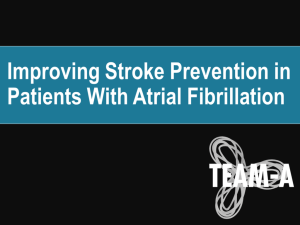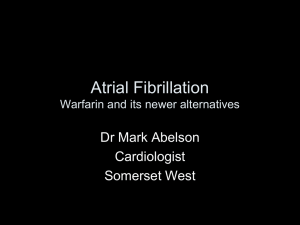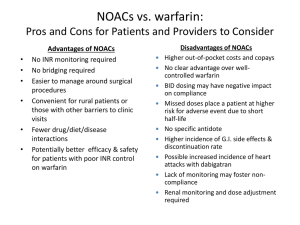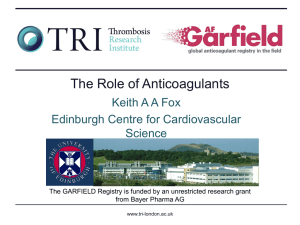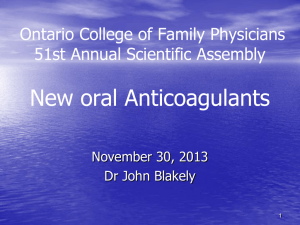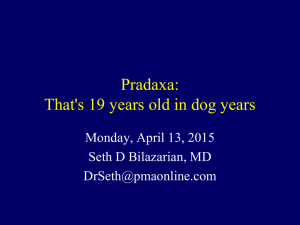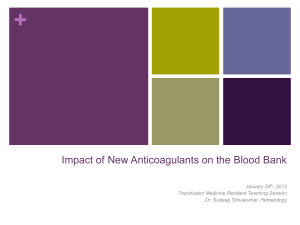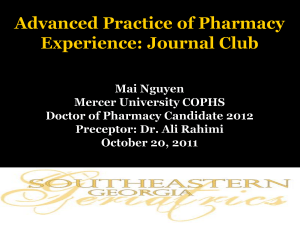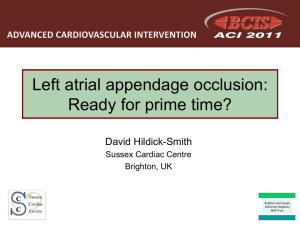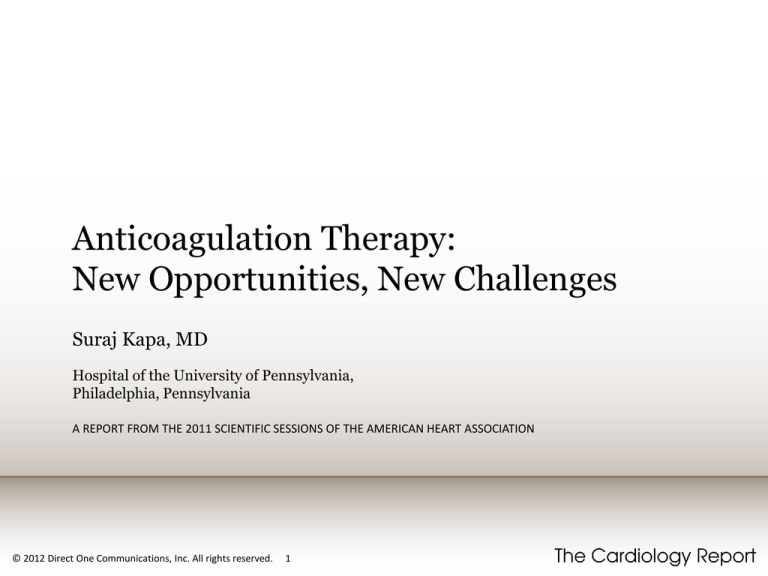
Anticoagulation Therapy:
New Opportunities, New Challenges
Suraj Kapa, MD
Hospital of the University of Pennsylvania,
Philadelphia, Pennsylvania
A REPORT FROM THE 2011 SCIENTIFIC SESSIONS OF THE AMERICAN HEART ASSOCIATION
© 2012 Direct One Communications, Inc. All rights reserved.
1
Indications for Oral Anticoagulation
Multiple clinical trials and guideline statements
support the use of long-term oral anticoagulation for
stroke prevention in high-risk patients with atrial
fibrillation (AF).1–8
Long-term oral anticoagulation is also a mainstay in
the management of patients with:
» Mechanical heart valves
» Deep venous thrombosis (DVT)
» Pulmonary embolism
© 2012 Direct One Communications, Inc. All rights reserved.
2
Shortcomings of Warfarin
Warfarin therapy requires control of patients’
prothrombin time or international normalized ratio
(INR) within a narrow therapeutic range.
Warfarin levels above the therapeutic range lead to
an increased risk of life-threatening bleeding, and
levels below the therapeutic range obviate any
potential benefits from the drug.
Ensuring maintenance of therapeutic INRs requires
frequent blood testing.
Multiple dietary and pharmacologic interactions may
complicate the maintenance of a therapeutic INR.9,10
© 2012 Direct One Communications, Inc. All rights reserved.
3
Thrombus Formation
In AF, the tissue factor pathway is the primary target
for preventing thrombus formation and stroke.12–15
Thrombus formation involves tissue factor-bearing
cells that come into contact with circulating
coagulation factors.
As factor VII comes into contact with tissue factor on
these cells, an activated complex forms, which
triggers factors IX and X.
Factor Xa and factor Va then form prothrombinase
complexes that activate prothrombin to thrombin,
which, in turn, then stimulates factor VII and other
components of the coagulation cascade.
© 2012 Direct One Communications, Inc. All rights reserved.
4
Coagulation Cascade
Schematic diagram of the
coagulation cascade along
the tissue factor pathway
and the targets of direct
factor Xa and thrombin
inhibitors. The vitamin K
antagonist warfarin typically
works on several calciumdependent clotting factors,
including factors II, VII, IX
(not shown), and X.
© 2012 Direct One Communications, Inc. All rights reserved.
5
Targeting Specific Coagulation Factors
Newer oral anticoagulants target specific points in
the coagulation cascade:
» Factor Xa inhibitors (eg, rivaroxaban, apixaban) target
factor Xa, preventing the conversion of prothrombin to
thrombin.
» Direct thrombin inhibitors (eg, dabigatran, ximelagatran)
target thrombin (factor IIa), blocking the conversion of
fibrinogen to fibrin.
The goal of novel oral anticoagulants is, in part, to
offer more specific targeting and to afford more
predictable responses than current anticoagulant
therapies, such as warfarin, can offer.
© 2012 Direct One Communications, Inc. All rights reserved.
6
The Ideal Oral Anticoagulant
Ideally, an oral anticoagulant would:
Require no remote monitoring
Have little interaction with food or other drugs
Offer a good safety profile with regard to bleeding
risk
Have similar efficacy to warfarin in reducing
thromboembolic events
Reach therapeutic levels within several hours
© 2012 Direct One Communications, Inc. All rights reserved.
7
Warfarin
When warfarin therapy is started, its anticoagulant
effects may not be apparent for several days.
The duration of action of a single dose is 2–5 days.
The therapeutic effect of warfarin exists within a
narrow therapeutic window as dictated by the INR.
Considerable inter- and intraindividual dose
variability may be affected by a wide range of
physiologic (liver and thyroid function), genetic, and
environmental (eg, diet, other drugs) factors.9,10
Regular monitoring is required to avoid excessive or
insufficient anticoagulation.16
© 2012 Direct One Communications, Inc. All rights reserved.
8
Dabigatran
Dabigatran etexilate is a direct thrombin inhibitor
that is given at a fixed oral dose without the need for
INR monitoring.17,18
Because of potential P-glycoprotein (P-gp)
interactions, its absorption may be decreased if
dabigatran is taken with a proton pump inhibitor.19
Excretion may be slowed in patients taking P-gp
pump inhibitors such as quinidine, verapamil, or
amiodarone, raising plasma levels of dabigatran.19
The drug has a relatively short half-life (12–17 hours).
Patients with acute or chronic renal failure may
require reduced doses.17,18
© 2012 Direct One Communications, Inc. All rights reserved.
9
Rivaroxaban and Apixaban
Rivaroxaban and apixaban are direct factor Xa
inhibitors.20–23 The two drugs interact slightly
differently with the S4 region of factor X.
Both rivaroxaban and apixaban bind to the
catalytic/active site of factor X and directly interfere
with the coagulation cascade.
They have predictable pharmacokinetics and allow
for fixed oral dosing without the need for INR
monitoring.
Similar to dabigatran, the half-lives of rivaroxaban
and apixaban are under 12 hours.
© 2012 Direct One Communications, Inc. All rights reserved.
10
Models of Care: Warfarin Therapy
Routine medical care, wherein a physician or office
staff manage warfarin dosing based on INRs
obtained from blood draws in a laboratory or via a
point-of-care device in the clinic.
Anticoagulation clinics managed by dedicated
healthcare professionals that have systematic
policies to manage and dose patients, using either
point-of-care or laboratory-based INRs.25–27
Patients using a point-of-care monitor at home to
measure their INRs and then reporting back to the
personnel in a clinic to alter the dose.28,29
© 2012 Direct One Communications, Inc. All rights reserved.
11
Switching to Newer Oral Anticoagulants
Advantages:
» Fixed oral dosing
» No need to monitor prothrombin time or INR
» Fewer drug interactions
» No dietary restrictions
Disadvantages:
» Lack of validated tests to assay their anticoagulant effect30
» No antidote readily available to halt bleeding
» More difficult to assess patient compliance
» Lack of data on long-term adverse effects beyond bleeding
» Absence of head-to-head comparisons between novel oral
anticoagulants
© 2012 Direct One Communications, Inc. All rights reserved.
12
Other Issues with Newer Anticoagulants
Peaks and troughs in anticoagulation levels may
result from their relatively shorter half-lives,
compared with warfarin.
The dosing of these drugs is fixed, so there is no easy
way to measure their therapeutic effects using
specific blood tests.
Additional monitoring of liver and renal function
may be needed to ensure that dose adjustments or
switching of agents is not required.
There is little to educate patients about beyond
compliance.
© 2012 Direct One Communications, Inc. All rights reserved.
13
Comparison of Oral Anticoagulants
© 2012 Direct One Communications, Inc. All rights reserved.
14
Anticoagulant Therapy and Stroke
Patients with AF-related stroke have a 1.8-fold
increase in mortality when compared with those who
experience a stroke unrelated to AF, possibly
because AF-related strokes tend to be larger in size
and more often lead to hemorrhagic
transformation.2,31,32
Although patients with AF and at least two
additional risk factors for stroke benefit from
warfarin therapy, many patients and their physicians
resist using warfarin because of concerns related to
INR monitoring, the risk of falls, and the potential
for bleeding and intracranial hemorrhage.
© 2012 Direct One Communications, Inc. All rights reserved.
15
INR Variability in AF Patients
Randomized clinical trials comparing dabigatran,
apixaban, and rivaroxaban with warfarin have shown
a strong trend toward the superiority of these novel
oral anticoagulants in preventing stroke and in
reducing the rate of intracranial hemorrhage.33–36
However, data from systematic overviews suggest
that patients on warfarin maintain a therapeutic INR
only 63% of the time at best, with even worse results
being observed in community practices.37
The importance of maintaining a minimum INR of
2.0 to obtain effective stroke prevention during
warfarin therapy has been well documented.38–41
© 2012 Direct One Communications, Inc. All rights reserved.
16
INR Variability in AF Patients
Analyses of data from the ROCKET AF, RE-LY, and
ARISTOTLE studies have shown no significant
difference in stroke outcomes between patients given
a novel oral anticoagulant and those using
warfarin.33–36,42
However, RE-LY data showed that 50% of patients
using warfarin who had a therapeutic INR at least
67% of the time had a composite event rate of 5.48,
which was lower than the event rates among patients
using dabigatran, whereas patients who were in the
therapeutic range less than 54% of the time had an
event rate of 12.32, which was much worse than the
event rate in patients taking dabigatran.42
© 2012 Direct One Communications, Inc. All rights reserved.
17
INR Variability in AF Patients
In the SPORTIF trial, 25% of patients who had the
greatest percentage of time in the therapeutic INR
range had the lowest event rates; however, patients
who were in the therapeutic range less than 60% of
the time had much higher event rates.43,44
In the ATRIA study, there was an 8-fold increase in
ischemic events with any reduction in the INR < 1.3;
if the INR was > 4.0, there was a 12-fold increase in
intracranial hemorrhage.45
© 2012 Direct One Communications, Inc. All rights reserved.
18
Self-Monitoring of INR Levels
Self-testing may provide a better way to maintain
INR levels within a narrow therapeutic window.
Results from the THINRS trial suggested beneficial
trends in mortality, major bleeding, and stroke when
patients performed self-testing, rather than relying
on specific clinics for monitoring and managing their
anticoagulation therapy.46–48
Similarly, in the STOARM2 trial, INR management
improved with automated self-monitoring, with INR
values < 1.5 or > 5 seen in only 0.47% of patients.49
© 2012 Direct One Communications, Inc. All rights reserved.
19
Self-Monitoring of INR Levels
Other studies have suggested that anticoagulation
clinics run by clinical pharmacists may reduce major
events, hospitalizations, and emergency visits by
60%–80%, when compared with usual clinic-based
management of warfarin, and that weekly INR selftesting and self-management may reduce major
events by as much as 70% and mortality by as much
as 61%.28,29,46–51
Thus, some contend that the primary issue is to fix
how we are managing patients using warfarin rather
than to switch patients to another agent.
© 2012 Direct One Communications, Inc. All rights reserved.
20
Cost-Effectiveness
Cost-effectiveness analyses of newer anticoagulants
in preventing stroke in patients with AF are limited.
At a cost of $7–$9/day (two capsules), dabigatran
use may cost an estimated $10,000 per year of life
saved.52–54
However, this analysis does not consider direct
comparisons against the cost of maintaining patients
on warfarin under current models of care.
Further studies are needed to better analyze the
relative cost-effectiveness of warfarin versus that of
any of the newer oral anticoagulants and also to
consider the cost of improving INR management.
© 2012 Direct One Communications, Inc. All rights reserved.
21
Potential of Newer Oral Anticoagulants
Newer anticoagulant agents have issues55 not shared
with warfarin, including:
A shorter half-life with rapid offset and potential
attendant clotting risk
The need for a reversal agent in cases of acute
bleeding or at the time of emergent procedures
The lack of laboratory monitoring to evaluate patient
adherence
These newer agents are easy to use, and AF patients can
benefit from lower stroke risk without needing repeated
blood tests for INR monitoring, so the potential
benefits are obvious.
© 2012 Direct One Communications, Inc. All rights reserved.
22
Anticoagulant Therapy and DVT
The same concerns related to INR monitoring, the
narrow therapeutic window of warfarin, and the
wide variety of dietary and pharmacologic
interactions with warfarin still exist in treating
patients with DVT.
One key difference in these patients is that the goal is
treating an existing problem rather than preventing
a potential one.56,57
However, the decision to treat as an outpatient
versus as an inpatient is more difficult, because the
time to reach an effective therapeutic range on
warfarin varies from 2 to 5 days.
© 2012 Direct One Communications, Inc. All rights reserved.
23
Rivaroxaban vs Warfarin in DVT
In both the EINSTEIN DVT trial, which compared
rivaroxaban with warfarin, and in an extension of the
EINSTEIN trial, which examined the prevention of
recurrent venous thromboembolism with
rivaroxaban, a nonsignificant decrease in mortality
was noted with rivaroxaban therapy.58,59
The study population excluded use of interacting
medications (strong CYP3A4 inhibitors and
inducers) and patients with significantly elevated
liver function tests or renal impairment.
Warfarin-treated patients were within the
therapeutic INR range less than 60% of the time.
© 2012 Direct One Communications, Inc. All rights reserved.
24
Dabigatran vs Warfarin in DVT
In the RE-COVER trial, dabigatran was noninferior
to warfarin in treating acute DVT.60
The study population excluded patients if they had
recent unstable cardiovascular disease, baseline liver
function test results that were more than twice the
upper limit of normal, or significant renal
impairment.
As in the EINSTEIN DVT trial and similar clinical
trials in AF, warfarin-treated patients were within
the therapeutic INR range less than 60% of the time.
© 2012 Direct One Communications, Inc. All rights reserved.
25
Choosing an Oral Anticoagulant for DVT
Considerations related to the choice of an initial oral
anticoagulant for patients with acute DVT are similar to
those used for patients with AF, namely, the:
Ability to keep the patient on warfarin within
therapeutic INR levels
Costs of individual agents
Unknown long-term risks related to novel
anticoagulants
Lack of clarity regarding efficacy in patients with
significant liver or renal impairment
© 2012 Direct One Communications, Inc. All rights reserved.
26
Laboratory Monitoring
Although dabigatran can raise the INR, activated
partial thromboplastin time (aPTT), and thrombin
time, the degree of elevation has not been clearly
associated with its therapeutic effect.61
The ecarin clotting time (ECT)—in which a known
quantity of ecarin is added to the patient’s plasma
and the time to clotting is evaluated—has been
suggested for monitoring the anticoagulant activity
of dabigatran.61
ECT is notably unaffected by heparin or warfarin.61
Recently developed chromogenic dabigatran assays
may permit monitoring serum dabigatran levels.61
© 2012 Direct One Communications, Inc. All rights reserved.
27
Laboratory Monitoring
Similarly, an anti-factor Xa level may be used to
evaluate the therapeutic effects of rivaroxaban or
apixaban.61
These assays are not as quickly obtained or as widely
available as is the INR.
Furthermore, therapeutic ranges for these laboratory
tests remain to be determined.
© 2012 Direct One Communications, Inc. All rights reserved.
28
Managing Bleeding Complications
There is some evidence that the anticoagulant actions
of dabigatran and rivaroxaban may be reversible.62–65
Preclinical studies suggest that both recombinant
factor VIIa and prothrombin complex concentrate
(PCC) can reverse the effects of dabigatran and
rivaroxaban on bleeding time and aPTT.
Injection of PCC immediately reversed the
anticoagulant activity of rivaroxaban in 12 healthy
human volunteers but had no effect on dabigatraninduced increases in aPTT, ECT, or thrombin time.62
How these blood products might function in actual
emergent clinical situations is unknown.
© 2012 Direct One Communications, Inc. All rights reserved.
29
Conclusions
Although the introduction of rivaroxaban, apixaban,
and dabigatran has the potential to revolutionize the
day-to-day care of patients who require oral
anticoagulation therapy, the best use of these drugs
ultimately may need to be determined on a patientby-patient and center-by-center basis.
The efficacy of individual centers in managing INRs,
the ability to safely maintain a therapeutic INR range
in individual patients on warfarin, and the current
lack of a clear methodology for monitoring or
reversing the anticoagulant effects of these new
agents all must be taken into account when a patient
is switched from warfarin to them.
© 2012 Direct One Communications, Inc. All rights reserved.
30
Conclusions
The new era of anticoagulant therapy has resulted in
a milieu of studies and evolving guidelines to help
refine the optimum use of these novel agents as more
convenient and possibly safer therapeutic
alternatives to warfarin.
Future studies to examine the cost-effectiveness of
these agents and their impact on individual patients
and systems-based care, as well as head-to-head
comparisons of novel oral anticoagulants, will be the
key to understanding how these novel agents may
enter the current lexicon of anticoagulation.
© 2012 Direct One Communications, Inc. All rights reserved.
31
References
1.
Wann LS, Curtis AB, January CT, et al. 2011 ACCF/AHA/HRS focused update on the management of
patients with atrial fibrillation (updating the 2006 guideline): a report of the American College of
Cardiology Foundation/American Heart Association Task Force on Practice Guidelines. Circulation.
2011;123:104–123.
2.
Fuster V, Ryden LE, Cannom DS, et al. ACC/AHA/ESC 2006 guidelines for the management of patients
with atrial fibrillation: a report of the American College of Cardiology/American Heart Association Task
Force on Practice Guidelines and the European Society of Cardiology Committee for Practice Guidelines
(Writing Committee to revise the 2001 guidelines for the management of patients with atrial
fibrillation). Circulation. 2006;114:e257–e354.
3.
The Boston Area Anticoagulation Trial for AF Investigators. The effect of low-dose warfarin on the risk of
stroke in patients with nonrheumatic AF. N Engl J Med. 1990;323:1505–1511.
4.
Stroke Prevention in Atrial Fibrillation Investigators. Stroke Prevention in AF Study: final results.
Circulation. 1991;84:527–539.
5.
EAFT (European Atrial Fibrillation Trial) Study Group. Secondary prevention in non-rheumatic atrial
fibrillation after transient ischaemic attack or minor stroke. Lancet. 1993;342:1255–1262.
6.
Petersen P, Boysen G, Godtfredsen J, et al. Placebo-controlled, randomised trial of warfarin and aspirin for
prevention of thromboembolic complications in chronic atrial fibrillation: the Copenhagen AFASAK
study. Lancet. 1989;1:175–179.
7.
Ezekowitz MD, Bridgers SL, James KE, et al. Warfarin in the prevention of stroke associated with
nonrheumatic AF. Veterans Affairs Stroke Prevention in Nonrheumatic Atrial Fibrillation Investigators. N
Engl J Med. 1992;327:1406–1412.
8. Connolly SJ, Laupacis A, Gent M, et al. Canadian Atrial Fibrillation Anticoagulation (CAFA) study. J Am
Coll Cardiol. 1991;18:349–355.
9.
McMillin GA, Vazquez SR, Pendleton RC. Current challenges in personalizing warfarin therapy. Expert Rev
Clin Pharmacol. 2011;4:349–362.
© 2012 Direct One Communications, Inc. All rights reserved.
32
References
10. White PJ. Patient factors that influence warfarin dose response. J Pharm Pract. 2010;23:194–204.
11. Lader E, Martin N, Cohen G, et al. Warfarin therapeutic monitoring: is 70% time in the therapeutic range
the best we can do? J Clin Pharm Ther. 2011 Dec 16. Epub ahead of print.
12. Davie EW, Fujikawa K, Kisiel W. The coagulation cascade: initiation, maintenance, and regulation.
Biochemistry. 1991;30:10363–10370.
13. Davie EW. Biochemical and molecular aspects of the coagulation cascade. Thromb Haemost. 1995;74:1–6.
14. McVey JH. Tissue factor pathway. Best Pract Res Clin Haematol. 1999;12:361–372.
15. Nakamura Y, Nakamura K, Fukushima-Kusano K, et al. Tissue factor expression in atrial endothelia
associated with nonvalvular atrial fibrillation: possible involvement in intracardiac thrombogenesis.
Thromb Res. 2003;111:137–142.
16. Hirsh J, Dalen JE, Anderson DR, et al. Oral anticoagulants: mechanism of action, clinical effectiveness, and
optimal therapeutic range. Chest. 1998;114:445S–469S.
17. Redondo S, Martinez MP, Ramajo M, et al. Pharmacological basis and clinical evidence of dabigatran
therapy. J Hematol Oncol. 2011;4:53.
18. Hankey GJ, Eikelboom JW. Dabigatran etexilate: a new oral thrombin inhibitor. Circulation.
2011;123:1436–1450.
19. Liesenfeld KH, Lehr T, Dansirikul C, et al. Population pharmacokinetic analysis of the oral thrombin
inhibitor dabigatran etexilate in patients with non-valvular atrial fibrillation from the RE-LY trial. J
Thromb Haemost. 2011;9:2168–2175.
20. Perzborn E, Roehrig S, Straub A, et al. Rivaroxaban: a new oral factor Xa inhibitor. Arterioscler Thromb
Vasc Biol. 2010;30:376–381.
21. Laux V, Perzborn E, Kubitza D, Misselwitz F. Preclinical and clinical characteristics of rivaroxaban: a novel,
oral direct factor Xa inhibitor. Semin Thromb Hemost. 2007;33:515–523.
© 2012 Direct One Communications, Inc. All rights reserved.
33
References
22. Raghavan N, Frost CE, Yu Z, et al. Apixaban metabolism and pharmacokinetics after oral administration to
humans. Drug Metab Dispos. 2009;37:74–81.
23. He K, Luettgen JM, Zhang D, et al. Preclinical pharmacokinetics and pharmacodynamics of apixaban, a
potent and selective factor Xa inhibitor. Eur J Drug Metab Pharmacokinet. 2011;36:129–139.
24. Potpara TS, Lip GY. New anticoagulation drugs for atrial fibrillation. Clin Pharmacol Ther. 2011;90:502–
506.
25. Nutescu EA, Bathija S, Sharp LK, et al. Anticoagulation patient self-monitoring in the United States:
considerations for clinical practice adoption. Pharmacotherapy. 2011;31:1161–1174.
26. MacGregor SH, Hamley JG, Dunbar JA, et al. Evaluation of a primary care anticoagulant clinic managed by
a pharmacist. BMJ. 1996;312:560.
27. Edgeworth A, Coles EC. An evaluation of near-patient testing of anticoagulant control in general practice.
Int J Health Care Qual Assur. 2010;23:410–421.
28. Gardiner C, Longair I, Pescott MA, et al. Self-monitoring of oral anticoagulation: does it work outside trial
conditions. J Clin Path. 2009;62:168–171.
29. Perera R, Heneghan C, Fitzmaurice D. Individual patient meta-analysis of self-monitoring of an oral
anticoagulation protocol. J Heart Valve Dis. 2008;17:233–238.
30. Lindhoff-Last E, Samama MM, Ortel TL, et al. Assays for measuring rivaroxaban: their suitability and
limitations. Ther Drug Monit. 2010;32:673–679.
31. Wolf PA, Mitchell JB, Baker CS, et al. Impact of atrial fibrillation on mortality, stroke, and medical costs.
Arch Intern Med. 1998;158:229–234.
32. Lin HJ, Wolf PA, Kelly-Hayes M, et al. Stroke severity in atrial fibrillation: the Framingham Study. Stroke.
1996;27:1760–1764.
33. Connolly SJ, Ezekowitz MD, Yusuf S, et al. Dabigatran versus warfarin in patients with atrial fibrillation. N
Engl J Med. 2009;361:1139–1151.
© 2012 Direct One Communications, Inc. All rights reserved.
34
References
34.
Patel MR, Mahaffey KW, Garg J, et al. Rivaroxaban versus warfarin in nonvalvular atrial fibrillation. N
Engl J Med. 2011;365:883–891.
35.
Granger CB, Alexander JH, McMurray JJ, et al. Apixaban versus warfarin in patients with atrial
fibrillation. N Engl J Med. 2011;365:981–992.
36.
Connolly SJ, Eikelboom J, Joyner C, et al. Apixaban in patients with atrial fibrillation. N Engl J Med.
2011;364:806–817.
37.
Connolly SJ, Pogue J, Eikelboom J, et al. Benefit of oral anticoagulant over antiplatelet therapy in atrial
fibrillation depends on the quality of international normalized ratio control achieved by centers and
countries as measured by time in therapeutic range. Circulation. 2008;118:2029–2037.
38.
Hart RG, Benavente O, McBride R, Pearce LA. Antithrombotic therapy to prevent stroke in patients with
atrial fibrillation: a meta-analysis. Ann Intern Med. 1999;131:492–501.
39.
Hylek EM, Go AS, Chang Y, et al. Effect of intensity of oral anticoagulation on stroke severity and
mortality in atrial fibrillation. N Engl J Med. 2003;349:1019–1026.
40.
Van Walraven C, Hart RG, Singer DE, et al. Oral anticoagulants vs aspirin in nonvalvular atrial
fibrillation: an individual patient meta-analysis. JAMA. 2002;288:2441–2448.
41.
Hylek EM, Skates SJ, Sheehan MA, Singer DE. An analysis of the lowest effective intensity of
prophylactic anticoagulation for patients with nonrheumatic atrial fibrillation. N Engl J Med.
1996;335:540–546.
42.
Wallentin L, Yusuf S, Ezekowitz MD, et al. Efficacy and safety of dabigatran compared with warfarin at
different levels of international normalised ratio control for stroke prevention in atrial fibrillation: an
analysis of the RE-LY trial. Lancet. 2010;376:975–983.
43.
Hylek EM, Frison L, Henault LE, Cupples A. Disparate stroke rates on warfarin among contemporaneous
cohorts with atrial fibrillation: potential insights into risk from a comparative analysis of SPORTIF III
versus SPORTIF V. Stroke. 2008;39:3009–3014.
© 2012 Direct One Communications, Inc. All rights reserved.
35
References
44. Amouyel P, Mismetti P, Langkilde LK, et al. INR variability in atrial fibrillation: a risk model for
cerebrovascular events. Eur J Intern Med. 2009;20:63–69.
45. Fang M, Go A, Chang Y, et al. Development of a new risk stratification scheme to predict warfarinassociated hemorrhage: the AnTicoagulation and Risk Factors in AF (ATRIA) study. Circulation.
2010;122:A16443. Abstract.
46. Matchar DB, Jacobson AK, Edson RG, et al. The impact of patient self-testing of prothrombin time for
managing anticoagulation: rationale and design of VA cooperative study #481—The Home INR Study
(THINRS). J Thromb Thrombolysis. 2005;19:163–172.
47. Dolor RJ, Ruybalid RL, Uyeda L, et al. An evaluation of patient self-testing competency of prothrombin
time for managing anticoagulation: pre-randomization results of VA Cooperative Study #481—The Home
INR Study (THINRS). J Thromb Thrombolysis. 2010;30:263–275.
48. Matchar DB, Jacobson A, Dolor R, et al. Effect of home testing of international normalized ratio on clinical
events. N Engl J Med. 2010;363:1608–1620.
49. Bussey HI. The future landscape of anticoagulation management. Pharmacotherapy. 2011;31:1151–1155.
50. Watzke HH, Forberg E, Svolba G, et al. A prospective controlled trial comparing weekly self-testing and
self-dosing with the standard management of patients on stable oral anticoagulation. Thromb Haemost.
2000;83:661–665.
51. Cromheecke ME, Levi M, Colly LP, et al. Oral anticoagulation self-management and management by a
specialist anticoagulation clinic: a randomised cross-over comparison. Lancet. 2000;356:97–102.
52. Banerjee A, Lane DA, Torp-Pedersen C, Lip GY. Net clinical benefit of new oral anticoagulants (dabigatran,
rivaroxaban, apixaban) versus no treatment in a “real world” atrial fibrillation population: a modelling
analysis based on a nationwide cohort study. Thromb Haemost. 2011 Dec 21. Epub ahead of print.
53. Pink J, Lane S, Pirmohamed M, Hughes DA. Dabigatran etexilate versus warfarin in management of nonvalvular atrial fibrillation in UK context: quantitative benefit-harm and economic analyses. BMJ.
2011;343:d6333. Epub ahead of print.
© 2012 Direct One Communications, Inc. All rights reserved.
36
References
54. Freeman JV, Zhu RP, Owens DK, et al. Cost-effectiveness of dabigatran compared with warfarin for stroke
prevention in atrial fibrillation. Ann Intern Med. 2011;154:1–11.
55. Eikelboom JW, Wallentin L, Connolly SJ, et al. Risk of bleeding with 2 doses of dabigatran compared with
warfarin in older and younger patients with AF: an analysis of the randomized evaluation of long-term
anticoagulant therapy (RE-LY) trial. Circulation. 2011;31:2363–2372.
56. Jaff MR, McMurtry S, Archer SL, et al. Management of massive and submassive pulmonary embolism,
iliofemoral deep vein thrombosis, and chronic thromboembolic pulmonary hypertension: a scientific
statement from the American Heart Association. Circulation. 2011;123:1788–1830.
57. Kearon C, Kahn SR, Agnelli G, et al. Antithrombotic therapy for venous thromboembolic disease: American
College of Chest Physicians evidence-based clinical practice guidelines (8th edition). American College of
Chest Physicians. Chest. 2008;133(suppl):454S–545S.
58. The Einstein Investigators. Oral rivaroxaban for symptomatic venous thromboembolism. N Engl J Med.
2010;363:2499–2510.
59. Romualdi E, Donadini MP, Ageno W. Oral rivaroxaban after symptomatic venous thromboembolism: the
continued treatment study (EINSTEIN-Extension study). Expert Rev Cardiovasc Ther. 2011;9:841–844.
60. Schulman S, Kearon C, Kakkar AK, et al. Dabigatran versus warfarin in the treatment of acute venous
thromboembolism. N Engl J Med. 2009;361:2342–2352.
61. Favaloro EJ, Lippi G, Koutts J. Laboratory testing of anticoagulants: the present and future. Pathology.
2011;43:682–692.
62. Eerenberg ES, Kamphuisen PW, Sijpkens MK, et al. Reversal of rivaroxaban and dabigatran by
prothrombin complex concentrate: a randomized, placebo-controlled, crossover study in healthy subjects.
Circulation. 2011;124:1573–1579.
© 2012 Direct One Communications, Inc. All rights reserved.
37
References
63. van Ryn J, Stangier J, Haertter S, et al. Dabigatran etexilate—a novel, reversible, oral direct thrombin
inhibitor: interpretation of coagulation assays and reversal of anticoagulant activity. Thromb Haemost.
2010;103:1116–1127.
64. Battinelli EM. Reversal of new oral anticoagulants. Circulation. 2011;124:1508–1510.
65. Romualdi E, Rancan E, Siragusa S, Ageno W. Managing bleeding complications in patients treated with the
old and the new anticoagulants. Curr Pharm Des. 2010;16:3478–3482.
© 2012 Direct One Communications, Inc. All rights reserved.
38

